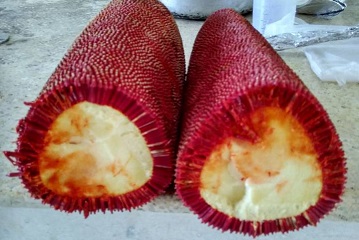A Group of IPB Researchers Utilized buah merah (“red fruit”) as Natural Colouring Agent for Sausage

A sausage is a cylindrical meat product usually made from ground meat, often pork, beef, or veal, along with salt, spices and other flavourings, and breadcrumbs, encased by a skin. Typically, a sausage is formed in a casing traditionally made from intestine, but sometimes from synthetic materials. Sausages that are sold raw are cooked in many ways, including pan-frying, broiling and barbecuing. Some sausages are cooked during processing and the casing may then be removed. Some are made of beef or a mixture including beef. Good sausage begins with good meat. Beef sausage is one of the meat processed products that many people favoured. Food products obtained from a mixture of fine meat with flour or without the addition of other spices.
The colour of meat and sausages is crucially important when the consumer is about to make a purchase. To successfully place a product on the market, it is therefore especially important to optimise the colourful appearance of your finished product. Sausages require additional food ingredients to extend shelf life. A number of options are available for using natural colouring agents. The process of cooking and smoking the cured meat actually uses up the ingoing nitrite. Based on available evidence to date, nitrite as used in meat and meat products is considered safe because known benefits outweigh potential risks. Nitrite is able to extend the shelf life of sausage because it has antimicrobial properties that can inhibit bacterial growth.
Nitrite as colouring agent in the beef sausage manufacturing should not be used excessively. When nitrite is consumed in excess, it will adversely affect the health of the human body, can even lead to death.
With reference to such condition, a group of researchers of the Department of Animal Production and Technology, of the Faculty of Animal Science, of Bogor Agricultural Institute (FAPET IPB), namely Irma Isnafia Arief, Zakiah Wulandari and Danang Setiawan conducted research program on utilization of natural ingredients, namely buah merah ("red fruit"). instead of nitrite in the beef sausage manufacturing.
The extracted buah merah (Pandanus Conoideus) will produce two forms namely red fruit oil and red fruit paste. The resulting red fruit paste is generally used for animal feed and disposed of as waste. However, IPB team innovate by utilizing red fruit paste as a natural colouring agent for in the manufacture of beef sausage.
"Red-fruit paste contains natural antioxidant component such as α-carotenoids, β-carotenoids, β-cryptoxanthin, α-tocopherol and unsaturated fatty acids, particularly oleic, linoleic,. Red fruit paste contains tocopherols and carotene that serves to maintain endurance if consumed regularly. In addition, it also contains antioxidants that can inhibit free radicals, "said Irma.
This study aims to examine the physical, microbiological and organoleptic properties of beef sausages with the additional of red fruit paste and are stored in room temperature. The treatment given in this research was the addition of red fruit paste as much as 0% and 11% and were stored in the room temperature for 0, 5, 10, 15, 20 hours.
The results showed that the addition of red fruit paste in beef sausage enable the products to be kept for 10 hours at room temperature. Red fruit paste is able to inhibit free radical activity. In addition, with the addition of red fruit paste is able to reduce the level of acidity (pH) and water activity.
Based on the hedonic quality test, the addition of red fruit paste to the sausage produce bright colour, aroma and distinctive taste. It can be concluded that red fruit paste can be used as a natural colouring agent for food and might provide greater health beneficial effects. (Wied)



